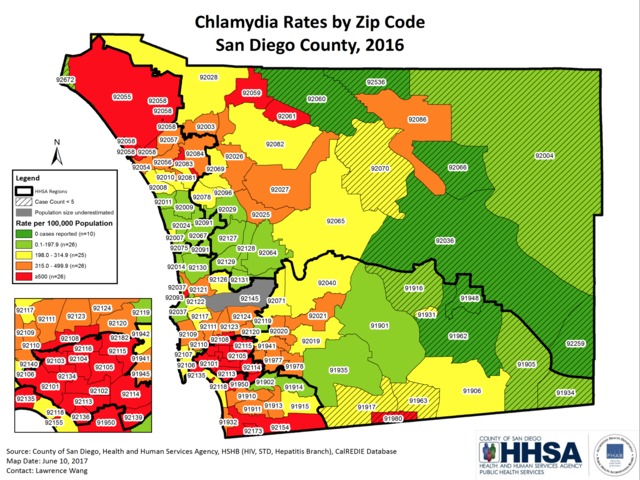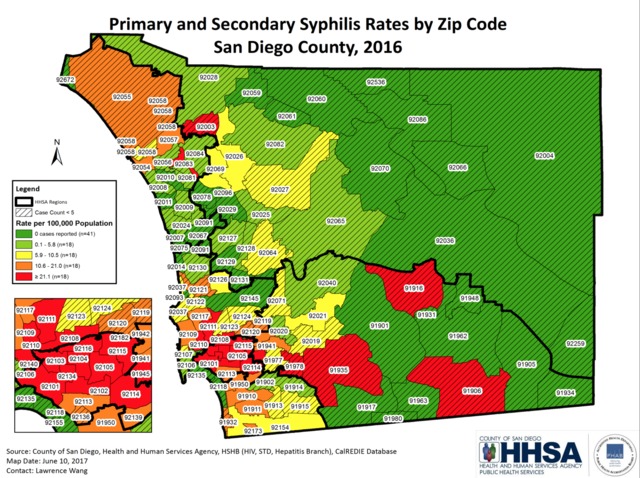(KGTV and CNN) - Rates of syphilis, gonorrhea and chlamydia are climbing in San Diego and the nation, the Centers for Disease Control and Prevention and San Diego County Health officials announced Tuesday.
At the National STD Prevention Conference in Washington, the CDC reported nearly 2.3 million US cases of these sexually transmitted diseases were diagnosed in 2017, according to preliminary data.
That's the highest number ever reported nationwide, breaking the record set in 2016 by more than 200,000 cases, according to the CDC.
"Sadly, it's not a surprising trend," said Rob Stephenson, a professor and director of the Center for Sexuality and Health Disparities at the University of Michigan in Ann Arbor, who was not involved in the new CDC research.
CHLAMYDIA
San Diego County health officials reported the rates of chlamydia rose roughly 8 percent from 2015 to 2016, to 18,904 cases total. Chlamydia, which remained the most common STD reported to the CDC, is easily transmitted during any form of sexual activity. If not treated, chlamydia can lead to pelvic inflammatory disease in women, which can cause permanent damage to the reproductive system. In men, the infection can spread to the tube that carries sperm from the testicles, causing pain and fever.
SYPHILIS
Syphilis cases were up almost 7 percent from 2015 to 2016, with a total of 523 cases. Syphilis can affect the heart, nervous system and other organs if left untreated. Syphilis is most often transmitted through sexual contact.
GONORRHEA
Gonorrhea cases had the highest local increase over one year, up 35 percent to 4,992. If not treated, gonorrhea can cause severe and permanent health issues, including problems with the prostate and testicles in men or problems with pregnancy and infertility in women. Gonorrhea is typically treated with a dual therapy of the antibiotics ceftriaxone and azithromycin.
The threat of antibiotic-resistant gonorrhea persists nationwide. If gonorrhea becomes resistant to all such combinations of antibiotic therapies, it could become an untreatable STD.
WHERE ARE THE CASES?
San Diego County health officials released maps detailing where the STD cases were reported in 2016.



"I think over the last five years, we've seen a rapid increase in the prevalence of sexually transmitted infections in the US, and we're also starting to see a plateau in our fight against the HIV epidemic, as well," Stephenson said.
The University of Michigan's Stephenson said that prevention is key to reducing the number of new STD cases -- such as practicing safe sex and getting tested regularly.
"Yet I think, when we think about sexually transmitted infections, we think of them through a curative lens, not a preventative lens," Stephenson said.
"We need to switch the dial on this in people's minds to think more about prevention rather than a too-late curative response," he said. "There's many ways we could do this. We could teach primary care providers and physicians to talk more about prevention with a client. We could start very early on in sex education by talking about the prevention of sexually transmitted diseases at young ages by giving people the behavioral skills they need to protect themselves."
At the same time, there have been declining resources for the CDC's Division of STD Prevention, said Dr. Edward Hook, endowed professor of infectious disease translational research at the University of Alabama at Birmingham's School of Medicine and scientific committee chair of the National STD Prevention Conference.
"The purchasing power of the CDC's budget for sexually transmitted disease prevention has declined 40% in the past 15 years," Hook said. "The CDC and the public health clinics, where most of this reporting comes from, represent the safety net for Americans, for people who may not have access to primary care providers or other sources of care. So the decline and the limited availability of resources for that is no doubt part of the contributor."
In recent years, state and local STD programs have seen budget cuts, too. In 2012, 52% of such programs experienced budget cuts, amounting to reductions in clinic hours, contact tracing and screening for common STDs, according to the CDC.
Additionally, the direct medical costs of treating STDs in the US are not cheap. The 19.7 million cases of sexually transmitted infections that occurred in 2008 in the US equaled about $15.6 billion in total lifetime direct medical costs, according to a study published in the journal Sexually Transmitted Diseases in 2013.
"I do think we've seen significant funding cuts in prevention efforts around sexual health in general," Stephenson said. "It's not a difficult jump to see how that's actually preventing us from winning the fight against negative sexual health outcomes."

